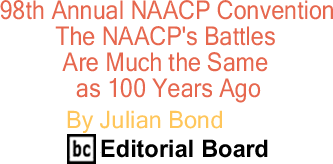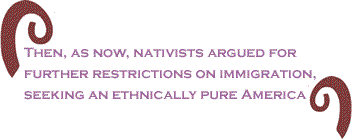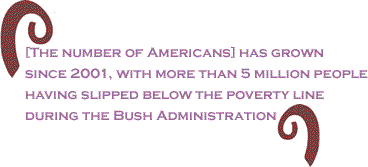
|
|||||||||||||||||||||
|
||||||||||
|
The current issue is always free to everyone If
you need the access available to a |
||||||||||
 |
||||||||||
 |
||||||||||
Note: This is the complete text of a speech by BlackCommentator Editorial Board member Julian Bond, Chairman of the NAACP Board of Directors that was given at the NAACP's 98th annual convention held this year at Cobo Hall in Detroit. To SCF Chairman Roy Levy Williams, Vice Chair Roslyn Brock, President Emeritus Rupert Richardson, other members of the Board of Directors and SCF Trustees, Detroit Branch President Wendell Anthony, Interim CEO Dennis Hayes, NAACP staff, members, friends and guests, welcome to Detroit � home of the largest NAACP branch in the nation. Detroit is also home to the dean of the Congressional Black Caucus, the Honorable John Conyers, Jr. It could not be more fitting that Representative Conyers is this year�s recipient of the Spingarn Medal, the highest honor the NAACP bestows, which will be presented to him on Thursday night. Last fall�s midterm elections did not increase the number of blacks in Congress, which is 43, but it vastly increased their power, elevating more of them to key positions than ever before in our nation�s history. Those elections gave blacks 4 House Committee chairmanships, including Charles Rangel, who heads the all-powerful Ways and Means Committee and John Conyers, now Chairman of the all-important Judiciary Committee. The other side was so worried about this possible ascendancy of black power that, weeks before the elections, one of their strategists said that �the party was seeking to �hammer home what a Pelosi-Rangel-Conyers House would really mean.��[i] Now we know! No wonder they were frightened! It also meant another change all Americans can be proud of. Speaker Nancy Pelosi chose to elevate her staffer and our very own Lorraine Miller, President of the DC Branch and of Region VII, to Clerk of the House of Representatives, making her the first black person to hold that prestigious post. There�s another woman in the NAACP that all of us are proud of and grateful to. She is our second longest serving employee, and after being on staff for 43 years, she is retiring. Doris Edwards � we thank you and wish you the very best. I can�t help but feel this will be an auspicious convention. We meet in Detroit for the seventh time, in the seventh month of the seventh year of the 21st Century! Seven is thought by many cultures to be a favorable number. Seven candles are lit during Kwanza. There are seven wonders of the world. Seven stars form the Big Dipper. There are seven levels of heaven in the Islamic tradition. The orthodox Jewish bride circles her groom seven times. Buddha is said to have walked seven steps upon his birth. Should any of you venture into one of the nearby casinos, after the convention business is done for the day, of course, you�ll hit the jackpot with the combination 7 � 7 � 7. And you don�t have to go a casino to find someone who would be glad to �combinate� those numbers for you. So we expect great things out of this convention � not least the visit on Thursday by virtually all of the Presidential candidates. Apparently a few people think we�re still relevant today. Detroit has a long racial history. The first racial uprising here occurred in 1833. The Blackburns � husband and wife Thornton and Lucie � were Kentucky slaves who escaped to Detroit one-hundred-and-seventy-six years ago this month. They were captured and jailed two years later. She escaped after exchanging clothes with a friend who stayed behind in her place. He was rescued the next day by supporters who stormed the jail, an event that became known as the Blackburn Riot. After the couple was spirited across the Detroit River to Canada, they were imprisoned again. That resulted in a ruling that they could not be extradited to the United States, making Canada from then on a protective home for fugitive slaves. In 1926, the NAACP hired Clarence Darrow to successfully defend Henry and Ossian Sweet who had been charged with murder after exercising the American right to self-defense when a white mob attacked their Detroit home.
One-hundred-and-ten years after the Blackburn Riot, there would be race riots in Detroit in 1943. And this year we mark the 40th anniversary of the 1967 Detroit riots. That rioting started in the Twelfth Street neighborhood. Virtually all-white in 1940, the area was almost all-black by 1960. This rapid transition was attended by myriad social ills, including police brutality and poor housing. On a July night in 1967, police raided a blind pig, or after-hours social club. Vandalism, looting and fires ensued. Within 48 hours, the National Guard was mobilized, followed two days later by the 82nd Airborne Division. Five days of disorder left 43 dead, almost 1200 injured, and more than 7,000 under arrest. This is also the 40th anniversary of Loving v. Virginia, the Supreme Court case that abolished anti-miscegenation laws and made it possible for my wife and me to get married in the state that would boast �Virginia Is for Lovers� many years later. And of course, this is the 50th anniversary of the Little Rock School integration crisis. We honored the courage of the Little Rock Nine and their parents by holding our May Board meeting in Little Rock, along with our Daisy Bates Education Summit. In a cruel irony, the United States Supreme Court observed the 50th anniversary of Little Rock by gutting Brown v. Board, the historic case which gave birth to Little Rock and was supposed to end school segregation. Until about 25 years ago, remarkable progress toward that goal was made under Brown. �From 1954 to 1982, [Supreme Court] Justices of all persuasions � from William Brennan to Lewis Powell to William Rehnquist � agreed that race-conscious integration policies stand in harmony, not tension, with Brown.�[ii] Indeed, for most of us, the notion that race ought not be considered in remedying racial discrimination is ludicrous. Now the ludicrous has become law. The Bush Court, on the same day the bald eagle was removed from the endangered species list, removed black children from the law�s protection. In two cases from Louisville and Seattle, the Court held by a 5 � 4 vote that those school systems could not voluntarily use race in assigning students to schools. This is the most radical in a line of cases beginning in the 1980s that questioned race-conscious policies. Only Justice Kennedy stood between this ruling and total disaster. Four members of the Court � the right-wing brothers Scalia and Thomas and Bush appointees Alito and Roberts - would have prohibited any use of race in remedying school segregation. The truth is, there are no non-racial remedies for racial discrimination.� In order to get beyond race, you have to go to race. To suggest racial neutrality as a remedy for racial discrimination is sophistry of the highest order. At a time when school segregation is increasing, a plurality of the Court would condemn minority children to secondary status before they�ve even started secondary school. There are two immediate lessons we can draw from this. One is to not allow this plurality to become a majority. That is, no more Bush appointees to the Supreme Court! No more appointees, period, who cannot see that there is no constitutional equivalence between race-conscious efforts to segregate and race-conscious efforts to integrate public schools. The second is that we must help school districts find solutions that will fit within Justice Kennedy�s permissible range of race-consciousness. As we find ourselves re-fighting battles we thought we had already won, we are reminded that the NAACP is as needed now as ever.
That�s not just what we think.� That�s what objective surveys have consistently said. A 1993 leadership study by Brakeley, John Price Jones, Inc., showed 75% of blacks believed the NAACP the leader among groups with civil rights, social justice and race relations agendas. An October 1995 US News and World Report poll reported 90% of blacks supported the NAACP. In an April 1998 poll conducted by the Foundation for Ethnic Understanding, 81% of blacks reported a favorable opinion of the NAACP. Now I have the pleasure of announcing the results of a survey taken just two weeks ago. Conducted by the respected firm Penn, Schoen & Berland Associates, this poll confirms that our work is both valuable and valued. The NAACP has the highest favorability of 17 organizations working in the civil rights arena. The NAACP is viewed favorably by almost all blacks � 94%, including 70 percent who view it very favorably, and by three-quarters of the general public. Fully 93 percent of blacks surveyed believe the NAACP represents the interests of the American-American community, and 67 percent believe this strongly.[iii] It was ninety-eight years ago, during the first week of 1909, when three people met to form what would become the NAACP. One was the descendant of abolitionists, the second was Jewish, and the third was a Southerner � a Southerner whose mother's people were Kentucky slaveholders, as my father's people were Kentucky slaves. That first meeting produced a Call � issued on February 12, 1909, the 100th anniversary of Abraham Lincoln's birth. The Call asked the nation then as we ask it today: "How far has it gone in assuring to each and every citizen, irrespective of color, the equality of opportunity and equality before the law, which underlie our American institutions and are guaranteed by the Constitution?" It called upon "all [the] believers in democracy" to gather for a national conference which eventually resulted in the NAACP. The original incorporation papers of the NAACP listed as its goals: "To promote equality of rights and eradicate caste or racial prejudice among the citizens of the United States; to advance the interest of colored citizens; to secure for them impartial suffrage; and to increase their opportunities for securing justice in the courts, education for their children, and complete equality before the law." That remains our mission today. Then, as now, nativists argued for further restrictions on immigration, seeking an ethnically pure America. Then, segregationists mandated the separation of blacks and whites in all public places; now, neo-segregationists want to end racial remedies in all public institutions and place restrictions on access to the ballot box which fall most heavily on racial minorities and the poor. Then, as now, racism masquerading as science proclaimed the genetic inferiority of black people, an acceptable antidote for the status anxieties of America's shrinking majority. And then, as now, racial scapegoating became a substitute for real solutions to complex problems, reminding us that while so much changes, too much remains the same. Ninety-eight years is a grand old age for a person; it is only a fraction in the lifetime of a nation. We are such a young nation so recently removed from slavery that only my father's generation stands between Julian Bond and human bondage; I am the grandson of a slave, as are many in this nation. My grandfather, James Bond, was born in 1863, in Kentucky; freedom didn�t come for him until the 13th Amendment was ratified in 1865. He and his mother were property, like a horse or a chair. As a young girl, she had been given away as a wedding present to a new bride, and when that bride became pregnant, her husband � that�s my great-grandmother�s owner and master � exercised his right to take his wife�s slave as his mistress. That union produced two children, one of them my grandfather.
At age 15, barely able to read and write, he hitched his tuition � a steer � to a rope and walked across Kentucky to Berea College and the college took him in. When my grandfather graduated from Berea, in 1892, the college asked him to deliver the commencement address. He said then:
In the first years of the 21st Century, we have been tested, as an organization and as a nation, by �hardships and adversity.� If my grandfather was right, we are now poised for �greater efforts and grander victories.� We�ve experienced some real losses at the NAACP in recent months. We lost our CEO, who couldn�t align our mission with his. We�ve lost more than 70 valuable employees because of the downsizing our finances forced upon us. But we know if we cannot bear the cross, we cannot wear the crown. The NAACP will emerge from this period healthier than we were before. The right-sizing process, as painful as it is for those most affected, forces us to be leaner, meaner, and keener. We have a search process in place that will produce a new CEO who will embrace our mission and take our organization to new heights. We are in the early stages of a drive to put one hundred million dollars in our treasury by our Centennial in 2009, and that drive is going well. Each member of our Board of Directors and Special Contribution Fund has agreed to �give or get� at least $15,000 by year�s end, and I am happy to tell you, several have already reached or passed that goal and by year�s end, all of them will.
Leadership 500, spearheaded by our Vice- Chair Roslyn Brock, has already contributed $230,000 to our Centennial Campaign. On Friday, more than 250 professionals gathered here under their umbrella to talk about civil rights. Our State Conferences and Branches, as always, also have put their shoulders to the wheel. They�re raising money too. They won�t let us down. They will lift us up. Our programs are continuing, our purpose and commitment are strong, our dedication to justice is unwavering. We are poised for �greater efforts and grander victories.� So is our nation. Already, our democracy is healthier than it was last year. We affirmed the words of Thomas Jefferson, who said in 1798:
What happened on Election Day last November was not an election � it was an intervention! �The people, recovering their true sight,� have begun to �restore their government to its true principles.� President Bush has seen his presidency repudiated, from the natural disaster of Katrina � to which he did not respond � to the disaster in Iraq which he created. The extent of the repudiation was evident late last month when the immigration reform bill, the centerpiece of the Administration�s domestic legislative hopes, died in the Senate. On the procedural vote that determined the bill�s fate, only 12 of the Senate�s 49 Republicans stood with the President. When Bush came to shove, his own party members pushed back. The demise of the immigration measure was widely interpreted to mean the Administration�s domestic agenda is likely finished. With his approval rating hovering below the freezing mark, most Americans seem to wish the Bush presidency were finished. The damage done, at home and abroad, is immense. There is no better way to examine the state of race in Bush�s America than to examine Katrina and the lessons it has to teach us.
Imagine a major hurricane hits New Orleans.� Within hours the President of the United States is on Air Force One headed for the stricken city.� Upon landing in the no-electricity darkness, with a flashlight held to his face, he announces, �This is the President of the United States and I�m here to help you!�[vi] The year was 1965.� The President, Lyndon Johnson. Forty years later a more devastating hurricane strikes New Orleans.� Neither the President nor any other federal official is there to help.� The city would sustain lasting damage � and so would the President. Thousands would be stranded, and they would be overwhelmingly black and poor.� That was horrendous enough.� Even worse was that it would take five days before meaningful help would arrive. Some would say, with no apology to Clarence Thomas, that we witnessed a modern-day lynching. In 1935, my parents were living in Louisiana when a neighbor�s cousin, Jerome Wilson, was lynched.� Writing about the lynching, my father �stopped short of arguing that lynching was a deliberate effort to dispossess black landholders.� . . .� He did show, however, that lynching could destroy the work of several generations in a single day.�[vii] The same, of course, could be said of Katrina.� A case in point is New Orleans� Lower Ninth Ward.� The Lower Ninth, one of the most heavily damaged areas of the city, was almost exclusively black.� Although its poverty rate was higher than the city as a whole, so was its rate of home ownership.� Almost 60 percent of the Lower Ninth�s residents owned their own homes, compared with 47 percent in the city as a whole, partly as a result of homes being passed down through generations in this deeply rooted community. Now, as it appears increasingly likely that the Lower Ninth Ward will not be rebuilt, it can be said that Katrina, like lynching, not only �destroy[ed] the work of generations in a single day,� but is resulting in �a deliberate effort to dispossess black landholders.� We should bear in mind that Katrina did not occur in a vacuum. The Gulf War was not removed from the Gulf Coast.� Katrina served to underscore how the war in Iraq has weakened, rather than strengthened, our defenses, including our levees. The problem isn't that we cannot prosecute a war in the Persian Gulf and protect our citizens on the Gulf Coast at home.� The problem is that we cannot do either one. They used September 11th as an excuse to wage war in Iraq. They used the hurricane to wash away decent pay for workers and for minority- and women-owned businesses. They are turning the recovery over to the same no-bid corporate looters who are profiting from the disaster of Iraq. They boasted that they wanted to make the government so small it would drown in a bathtub - and in New Orleans, it did.
This is the first lesson that emerges from Katrina - it teaches us the consequences of anti-government government, under which government's role in protecting its people is limited or destroyed and government is used exclusively to wage war and protect and defend corporate interests. One of the other lessons, all of which are interconnected, is the highlighting of the racial and class divide in this country. Although New Orleans was unique in many ways - music, cuisine, culture - its race and class issues were the norm and not the exception. And finally, Katrina resulted in a loss of moral authority for the United States, at home and abroad. Americans were not the only ones who watched Katrina's disaster unfold on television. The images were seen around the world. If we at home felt revulsion and shame, imagine what our enemies abroad thought - or even our friends. It is reminiscent of the role segregation played in international politics. n 1946, Secretary of State Dean Acheson wrote:
The Truman Administration's brief in Brown v. Board of Education argued that school desegregation was in the national interest because of foreign policy concerns. The United States, the brief argued:"is trying to prove to the people of the world, of every nationality, race and color, that a free democracy is the most civilized and most secure form of government yet devised by man. Racial discrimination furnishes grist for the communist propaganda mills, and it raises doubts even among friendly nations as to the intensity of our devotion to the democratic faith." [viii] As survivors floundered and bodies floated in New Orleans' streets, neither "civilized" nor �secure" described our democratic form of government. And viewers, here and around the globe, wondered: where was that government in the time of these citizens' greatest need? The Administration's response to Hurricane Katrina was a gumbo of inaction, insensitivity and incompetence. The Administration�s indifference led rapper Kanye West, days after the hurricane, to famously remark, on live television, �George Bush doesn�t like black people.� His comment was not off-the-cuff.� It was premeditated and preceded by the following: �I hate the way they portray us in the media.� You see a black family, it says, �They�re looting.� You see a white family, it says, �They�re looking for food.�� And you know it�s been five days [waiting for federal help] because most of the people are black.�
Political scientist Michael Dawson and two colleagues surveyed blacks and whites as to whether West�s remarks were unjustified.� Only 9 percent of blacks answered "yes" compared to 56 percent of whites.[ix] This follows a pattern. Dr. Dawson also asked whether the government's response would have been faster if the victims had been white. Eighty-four percent of blacks said "yes" while only 20 percent of whites agreed. Similarly, in a Newsweek poll, twice as many blacks as whites - 65 percent versus 31 percent - thought the government responded slowly because the victims were black. When Dawson asked whether Katrina showed that racial inequality remains a major problem in the United States, 90 percent of blacks answered "yes" while only 38 percent of whites thought so. These responses are consistent with a much larger black/white divide: "nearly four-fifths of blacks (78%) believe that blacks will either never or not in their lifetimes achieve racial equality in the United States. On the other hand, nearly two-thirds of whites (66%) believe that blacks have either achieved or will soon achieve racial equality." [x] Life was not easy in the Big Easy for Lower Niners and other blacks before Katrina.� Four in ten black families lived in poverty, the highest rate in the nation for blacks living in cities.� The majority of these subsisted on incomes less than half the official poverty level. In the region affected by Katrina, more than one million lived in poverty before the storm.� Mississippi, Louisiana, and Alabama are, respectively, the first, second, and eighth poorest states in the union. Poverty in the United States is not confined to the South, of course.� Today, 37 million Americans live in poverty.� They represent about 13 percent of the population � the highest percentage in the developed world.� Their number has grown since 2001, with more than 5 million people having slipped below the poverty line during the Bush Administration. And the gap has grown between the haves and the have-nots.� The top 20 percent of earners take over half the national income, while the bottom 20 percent get just 3.4 percent.� Black Americans, of course, are more likely to be among the bottom-earners than the top.� Almost a quarter of black Americans nationwide live below the poverty line as compared to only 8.6 percent of whites. Almost every social indicator, from birth to death, reflects black-white disparities. Infant mortality rates are 146 percent higher for blacks; chances of imprisonment are 447 percent higher; rate of death by homicide 521 percent higher; lack of health insurance 42 percent more likely; the proportion with a college degree 60 percent lower. And the average white American will live 5 � years longer than the average black American.[xi]
Media images during the Katrina coverage made it obvious that the dying and the suffering were predominantly black and poor.� Though some wanted to engage in a �race or class� debate, even President Bush acknowledged that they are intertwined. In his Jackson Square speech, the President spoke of the �deep, persistent poverty� which exists in our country.� �That poverty�, he said, �has its roots in a history of racial discrimination.� The truth is that race trumps class.� As Michael Dyson has written,� �[c]oncentrated poverty doesn�t victimize poor whites in the same way it does poor blacks.�[xii]� That is why �[c]omparisons between poor whites and poor blacks in New Orleans . . . clearly showed that poor whites were much better off overall.�[xiii]� It is why �[t]he public school system served poor whites better than poor blacks; poor white children were less likely to attend schools in areas of concentrated poverty.�[xiv]� It is why three times as many poor blacks as poor whites lacked access to a vehicle. W.E.B. DuBois, one of the founders of the NAACP, was the first social theorist to link class to race.� He understood then what we must understand now:� �race never stands apart from economic realities.�[xv] In fact, race, in this circumstance and many others, is the crucial variable that proves that not all differences are equal. Present day inequality and racial disparities are cumulative.� They are the result of racial advantages compounded over time � and they �produce racialized patterns of accumulation and disaccumulation.� As a result, racial inequality is imbedded into the fabric of post-civil rights movement American society.� Today�s apologists argue that discrimination against minorities is not a problem; society has to protect itself from discrimination against the majority instead. It might have been proper yesterday, they maintain, to aim big guns at racism, at segregated jobs, schools and ballot boxes.� The ills we face today, they say, are crime, teenage pregnancy, welfare dependency and family disintegration.� These call, they claim, for new approaches and abandoning government�s help. But poverty�s symptoms must not be confused with poverty�s causes. DuBois knew this more than one hundred years ago.� In his landmark study that became The Philadelphia Negro, published in 1899, Dr. DuBois wrote:
Sadly, what was true more than one hundred years ago is still true today.� �The deplorable results� of government conduct and misconduct were on view for all to see in the wake of Katrina. We ought to use the lessons of Katrina to recapture the race issue from the political right, to return to a time when whites say, as President Johnson did in 1965, �[t]heir cause must be our cause, too.� Because it is not just Negroes, but really it is all of us, who must overcome the crippling legacy of bigotry and injustice.� In the past, Americans came to agree on guaranteeing blacks� right to vote and to integrate public places; they disagree strongly today, however, on both the wisdom of and techniques required for extending equality beyond these public spheres, and many even dispute whether anti-black bias still persists. Many Americans maintain � from corporate and government sponsored pulpits, newspaper op-ed pages and television and radio talk shows � that racial discrimination is an ancient artifact. Most of the people saying this are white, but some blacks have drunk the Kool Aid too.� Thus the �70s, �80s and �90s are now defined as a bias-free present where white supremacy has been vanquished, and black disadvantage is rooted in black misbehavior, where culture, not color, is at fault. At the NAACP, we know this is not true, and that�s why we are dedicated to an aggressive campaign of social justice, fighting racial discrimination. We�ve done this in the past and will continue to do it in the future. We have much more work to do. Just as the Supreme Court observed the 50th anniversary of Little Rock by repudiating Brown vs. Board, the Bush Administration has observed the 50th anniversary of the creation of the Justice Department�s Civil Rights Division by decimating its role as guardian of our nation�s civil rights. After the rules were changed to give political appointees more say in the hiring process, only 42 percent of the lawyers hired in the Civil Rights Division had civil rights experience compared with 77 percent in the years before the change. Of the experienced lawyers, almost half gained their experience on the wrong side of civil rights issues. The results are predictable: fewer voting rights and employment cases involving systematic discrimination against blacks and more alleging reverse discrimination against whites and religious discrimination against Christians. The Department brought only one case challenging voting plans on the basis of black vote dilution compared with eight cases during a comparable period in the Clinton Administration. It also brought the first case ever on behalf of white voters, alleging that a black Mississippian was intimidating whites at the polls. President Bush knew what he was talking about when he told us at last year�s convention that �many African-Americans distrust� the Republican Party. In my convention speech last year, I said that �the campaign to suppress the minority vote continues � in places high and low, federal and state.� We didn�t know then how high. Now we have compelling evidence �that the White House used the Justice Department�s Civil Rights and Criminal Division and the Election Assistance Commission to create a false impression of widespread voter fraud to justify initiatives � stringent voter identification laws, crackdowns on voter registration drives, and pre-election purges of eligible voters from the rolls � designed to disenfranchise the poor, minorities, students and seniors.�[xvii] In other words, �voter fraud� is a fraud! Yet U. S. Attorneys were fired for not pursuing bogus �voter fraud� claims. Others may have kept their jobs by prosecuting Democratic voters and officials. One such case � in the swing state of Wisconsin � was so flimsy that the appeals court took the extraordinary move of ordering the defendant released immediately. Partisanship, not principle, guides the Bush/Gonzalez Department of Justice. There is also news out of Florida about voting � and this time it is good news. Republican Governor Charlie Crist pushed through a plan that will allow all non-violent felons to regain their voting rights. Florida has almost one million disenfranchised ex-offenders � far more than any other state. The vast majority of them are black. Now roughly 80 percent of them will be able to vote, and we will help them find the registration office and the voting booth. There is nothing more important for us to be doing right now than ending felony disenfranchisement elsewhere and registering voters.� If you don�t believe one vote counts, look at the Supreme Court! But there are other things we must do too. We must make strengthening our Branches and State Conferences a first priority, building membership where it is low and insisting on activism where Branches are moribund. We must expand our outreach to and collaboration with our coalition partners � the time has long passed when we were the only soldiers in this fight. We cannot and should not go it alone. In the several states, we should be preparing now to present governors and legislators with an NAACP agenda, as the North Carolina State Conference has done. Among other items, it should include ending felony isenfranchisement, eradicating the scourge of predatory lending, and insuring all of the public�s children an equal education. Those are the things we ought to be doing. Let me tell you some of the things we recently have done.
In our regional conferences, thousands of NAACP activists met to plot ways they�d attack racial discrimination in the future. Hundreds of NAACP volunteers joined with the Red Cross in South Georgia communities affected by tornadoes. The Georgia NAACP asked the state legislature to join Virginia in apologizing for slavery and mobilized its Braches to beat back a return of predatory payday lending to the state. The Hazlehurst, Mississippi NAACP intervened on behalf of striking bus drivers in a labor dispute. The Norwalk, Connecticut NAACP asked for the removal of two judges accused of bullying minority defendants. The St. Paul NAACP voted to support the city�s first black fire chief after a no-confidence vote by the majority white firemen�s union. The NAACP and the ONE Campaign headlined by the singer/activist Bono announced a partnership in the fight against global AIDS and extreme poverty in Africa and the world�s poorest countries. The Sulphur Springs, Texas NAACP asked for an investigation of a beating of a black man. The North Carolina State NAACP presented the state legislature with a 14-point list of policy recommendations, including quality education for every child, a livable wage for all workers, universal healthcare, and readdressing past acts of racism to prevent current discrimination. The President of the North Carolina NAACP State Conference cited cross burnings, work place racial disputes and an incident in Oxford, N. C, in which a black couple were chased at gunpoint and subjected to racial slurs by a man with a Ku Klux Klan emblem on his truck as evidence of a rise in hate crimes in the state. The NAACP in Slater City, Missouri, charged that a recent report demonstrated African-Americans were 250 percent more likely to be searched than whites pulled over by police. Our Branch in Yonkers, New York, reported they receive 24 calls each month about police misconduct.� The Mississippi State NAACP Conference joined with Democratic officials and the state�s Republican Party to object to a photo identification requirement for primary elections. The Pittsburgh NAACP complained about race-based income disparities in the city. That�s a very small part of what our 2000 branches scattered around the United States do every day of every week, every year. Last month our Washington Bureau Director, Hilary Shelton, testified against the death penalty before the United States Senate, charging capital punishment is racially biased. Our civic engagement staff is working to roll-out a nationwide voter registration campaign. The nuances of our work may shift, but the core issues remain unchanged: poverty, a biased criminal justice system, denial of voting rights, unequal education, disparities in earning power and job opportunities, lack of health care. Ninety-eight years after it began, the NAACP is still fighting to eliminate the racism and prejudice that feed these inequalities and social ills. As long as these issues exist, the NAACP will be needed as an aggressive force seeking to eradicate them. One of the NAACP�s founders, Mary White Ovington, described how the early NAACP resisted compromising its principles:
We must never �side step� the main issue. Far from �slipping into oblivion�, today we have more than 30,000 youth members actively involved in the fight for civil rights. They exclusively elect seven youth members of the NAACP Board of Directors. We chartered 24 new youth units last year, our fastest growing membership segment, including 11 college chapters, 10 youth councils, and 3 high school chapters. They�ve started an aggressive STOP campaign to halt the denigration of black women and the coarsening of our culture. While we are happy to have sent a certain radio cowboy back to his ranch, we ought to hold ourselves to the same standard. If he can�t refer to our women as �Hos�, then we shouldn�t either. And it is not a violation of the First Amendment not to use the �N� word. We also have our Youth and College Division to thank for putting us on record against the war in Iraq before it started. At our most recent Board meeting in late May, we chartered seven new Youth Councils and two new college chapters We have 49 NAACP prison branches, fighting recidivism, aiding inmates' return to society, helping re-enfranchise former felons, and drawing their families into political action to alter the draconian laws that pack our prisons with African-American youth. We have a long and honorable tradition of social justice in this country. It sends forth the message that when we act together we have power beyond measure. At the NAACP, we have no permanent friends and no permanent enemies, just permanent interests, and those interests are justice and freedom. Langston Hughes might have been speaking for the NAACP when he wrote:
Thank you. BlackCommentator.com Editorial Board member, Julian Bond is Board Chairman, NAACP, the largest and oldest civil rights group in the country. In the 1960s, he co-founded the Student Non-Violent Coordinating Committee, renowned for its organizing work in the fight against racism. Bond also served 20 years in the Georgia Legislature, he holds twenty-five honorary degrees, is a Distinguished Professor at American University in Washington, DC, and a Professor in history at the University of Virginia. Click here to contact Mr. Bond [i] David D. Kirkpatrick, �Black Lawmakers Set to Take Crucial Posts Face Pressure,� The New York Times (Dec. 5, 2006). [ii] Goodwin, Liu, �The Meaning of Brown vs. the Board, Los Angeles Times, http://www.latimes.com (Dec. 25, 2006). [iii] NAACP, Penn, Schoen & Berland Associates, July 3, 2007. [iv] �Commencement Address,� by James Bond, Berea College Reporter (June 1892). [v] Thomas Jefferson, 1789, after the passage of the Sedition Act. [vi] ��Douglas Brinkley, The Great Deluge, at 340, Harper Collins (2006). [vii]� Horace Mann and Julia Bond, Adam Fairclough, ed., The Star Creek Papers, at xxx, University of Georgia Press (1997). [viii]�� Brief for the United States as Amicus Curiae at 6, Brown v. Board of Education, 347 U.S. 483 (1954). [ix]�� Michael C. Dawson, �After the Deluge,� at 239, DuBois Review, Vol. 3, No. 1 (Spring 2006). [x]�� Id. at 240. [xi] Imprisonment rates from U. S. Department of Justice, Office of Justice Programs, Bureau of Justice Statistics. All other statistics from compilation of statistics from the U. S. Census Bureau, Statistical Abstract of the United States: 2004 � 2005. [xii]�� Michael Eric Dyson, Come Hell or High Water, p. 145. Basic Civitas Books (2006). [xiii]� Monthly Review, id., at 8. [xiv]�� Id. [xv]�� Cedric Herring, �Hurricane Katrina and the Racial Gulf,� p. 131, DuBois Review, Vol. 3, No. 1 (Spring 2006). [xvi]�� W.E.B. DuBois, The Philadelphia Negro, p. 394 (1899). [xvii] �Curing the Rot at Justice,� The Nation, p. 5 (July 2, 2007). |
||||||||||
| August
2, 2007 Issue 240 |
|
| Printer Friendly Version in resizeable plain text format format |
 |
 |
 |
| |
| |









































